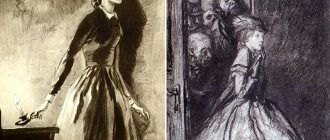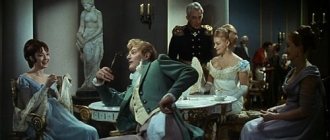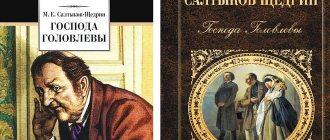The novel by the Spanish writer Miguel de Cervantes Saavedra is dedicated to the knight errant, the main character Don Quixote. In his work, the writer, in a parody form, describes the adventures of the noble hero and his faithful squire Sancho Panza. After the publication of Cervantes’s knightly tale, the concept of “quixoticism” arose, which remains relevant and topical in our time, because the struggle of one person against the system is a “war with windmills.” The chivalric novel by Cervantes de Saavedra is considered one of the best books of all time.
Main characters
Don Quixote | In Don Quixote, the hero who wanted to reorganize the world is a brave old nobleman who has read about the adventures of noble knights. He has his own vision of the world, he sees everything in his own way. For him, an old nag becomes a fighting, strong horse, a simple girl from the village becomes a lady of noble blood. Don Quixote sees the world as it was created by the imagination of a noble and generous hero. At the end of his epic, Don Quixote realizes what a thankless job it is - war with windmills, and he dies. |
Sancho Panza | Don Quixote's faithful friend and comrade-in-arms, selfless squire. A naive and gullible peasant who believed in the crazy ideas of Don Quixote. At first, he is a cunning and rogue scoundrel, but, constantly being next to the Knight of the Sad Image, he evolves and turns into an honest, fair and noble person. It contains folk wisdom, practicality and pragmatism, and next to his ally, he is imbued with the spirit of adventurism. |
Characteristic
Don Quixote spent most of his time reading books. This passion for books led Alonso to decide to devote the rest of his life to the fight against evil. The man imagined himself to be a knight, like the heroes of his favorite books. Having come up with a sonorous nickname for himself, riding Rocinante, he sets off on the most exciting journey of his life. Every knight must have a lady of his heart for whose sake he performs feats. In Don Quixote, she becomes an ordinary rural girl, for whom he also came up with a name. Now she is Dulcinea Toboso.
His imagination did not stop for a minute, drawing vivid pictures. He believed so much in the ideal world he had invented that he ceased to distinguish between reality and fiction.
Dreaminess and determination helped him fulfill his cherished desire. He didn't care that people thought he was a crazy old man. He endured ridicule and bullying directed at him. His life goal was what gave him strength and helped him move forward, stopping at nothing.
His kind heart and vulnerable soul did not want to put up with cruel injustice on earth. There was too much evil on her. He believed that people should help each other. They should not lie, be hypocritical, or offend the weak. Alonso himself never raised his hand to anyone. He has always been a defender of the weak. However, his good deeds usually backfired on him. This can be seen in the example of his intercession for a little boy who was being beaten by his owner. The convicts whom he freed, instead of being grateful for the freedom they received, threw stones at him. The barber he met on the road was mistaken for a knight errant. He takes away from him an imaginary copper shield, which in reality turned out to be a copper basin, with which he was only sheltering from the rain.
Reasonable and knowledgeable on many issues. He will always give wise and practical advice. It was he who helped and advised Sancho Panza during his reign on the island, becoming his mentor at this time.
Already at the beginning of the journey, Don Quixote realizes that he does not have the same strength. He is no longer a good fellow, but a tired and sick old man. He is unable to change the world around him for the better. The only place where he could feel like a knight was the ducal castle, but its inhabitants simply loved pranks and jokes too much.
The image of Don Quixote is an “eternal image”. The author tried to reflect in him the selfless desire to do good, be fair, perform noble deeds, and strive for high ideals. For their sake, the main character shows courage and the ability to sacrifice himself.
- Sancho Panza - Sancho Panza
Add to favorites
The novel by the Spanish writer Miguel de Cervantes Saavedra is dedicated to the knight errant, the main character Don Quixote. In his work, the writer, in a parody form, describes the adventures of the noble hero and his faithful squire Sancho Panza. After the publication of Cervantes’s knightly tale, the concept of “quixoticism” arose, which remains relevant and topical in our time, because the struggle of one person against the system is a “war with windmills.” The chivalric novel by Cervantes de Saavedra is considered one of the best books of all time.
Minor characters
Dulcinea Toboso | A simple peasant woman from a neighboring village, Aldonzo Lorenzo, a pretty girl, received from the lips of Don Quixote the honorary title of a noble lady, and the sonorous name of Dulcinea of Toboso. It was for the glory of this beautiful person that the Knight of the Sorrowful Image had to perform his exploits and throw defeated opponents at her feet, and Dulcinea had to decide their fate. For Don Quixote, she is a symbol of a beautiful lady, platonic love for whom drives his noble thoughts. |
Antonia | The young niece of a knight errant. He loves and respects Don Quixote very much and looks forward to his return home. Don Quixote bequeaths all his property to Antonia with the instruction that she will receive it only if she marries a man who has nothing to do with knights and chivalric romances. He sincerely worries about the illness and death of the noble knight. |
Don Quixote's Housekeeper | Don Quixote's faithful and devoted servant, who sincerely loves her reckless master. Handles business affairs. Don Quixote respects and appreciates his housekeeper, being near death, he specifically states in his will that the housekeeper be paid the entire amount in full for the entire duration of her service, and in addition, Don Quixote gives her additional money for a dress. |
Nicholas | The barber, a close friend of Don Quixote, is a reasonable and prudent person. He worries about the noble knight and tries with his advice to dissuade him from reckless ideas and actions. |
Samson Carrasco | Bachelor, one of the loyal and devoted friends of the Knight of the Sad Image. She is very worried about Don Quixote’s condition and is with him in his last hours of life. |
Eternal images in the novel by M. Cervantes “Don Quixote”
The novel “The Cunning Hidalgo Don Quixote of La Mancha” - one of the most popular works of world literature, created by the Spanish writer Miguel de Cervantes Saavedra (1547–1616) - tells about the adventures of a glorious knight who committed many heroic, but absolutely fruitless deeds for the sake of his beloved Dulcinea. Cervantes' novel Don Quixote itself is a parody of the chivalric romances of the Renaissance.
Don Quixote is the central character of this novel, his real name is Alonso Quejano. According to the writer German Arciniegas, one of the prototypes of Don Quixote for Cervantes could have been the conqueror of Colombia, Gonzalo Jimenez de Quesada, whose campaigns in search of El Dorado were overgrown with numerous speculations and legends.
The bibliography of studies of the image of Don Quixote by literary scholars, philosophers and other specialists is very extensive. The classics of literature also interpreted this image. Despite all the differences in interpretations, almost everyone who wrote about Don Quixote agreed on the statement that he is a universal human image, expressing the eternal properties of the human spirit; he was ranked among the “eternal companions” of humanity.
In addition, this image was subsequently repeatedly used in fiction by other authors, who gave it their own interpretation, parodied it, or referred to it. Already some contemporaries and closest literary descendants of Cervantes began to create imitations of his novel, which described the adventures of Don Quixote unknown to the reader. This trend was subsequently continued.
The image of Don Quixote was perceived by numerous researchers as an archetype of human nature, interpreted as a psychological category, even giving rise to the philosophical concept of “quixoticism” - the behavior and lifestyle of Don Quixote, a noble and beautiful-hearted dreamer who strives to benefit people in the name of unrealizable ideals.
All this indicates that the image of Don Quixote is an “eternal image” in literature.
“Eternal images” are artistic images of works of world literature in which the writer, based on the vital material of his time, was able to create a lasting generalization applicable in the life of subsequent generations. These images acquire a nominal meaning and retain artistic significance right up to our time.
The image of Don Quixote personifies a noble, but devoid of vital soil, dreaming.
Don Quixote's faithful companions are his squire Sancho Panza and his horse Rocinante.
Sancho Panza was a simple peasant farmer on the lands of Alonso Quejano, was married and had two children. Lured by Don Quixote's promises to make him a future count and governor of the island, Sancho agrees to accompany him as a squire. Not believing in Don Quixote's dreams and mirages, Sancho often shows common sense in his speeches and tries to dissuade Don Quixote from the most reckless exploits. Nevertheless, he willingly takes advantage of the benefits of knighthood errant. He is cunning and often tries to gain benefits through deception. Considering that Don Quixote is not himself, he nevertheless respects him for his intelligence and education.
The name of Don Quixote's horse is a compound word: “rosin” - nag; “ante” – before, ahead. Don Quixote spent a long time choosing a name for his horse - according to his plan, it should indicate its past and present, and correspond to the new type of activity and status of the owner. As a result, he settled on the name Rocinante - in his opinion, it was “noble and sonorous, explaining that before this horse was an ordinary nag, now, ahead of everyone else, it has become the first nag in the world.”
Cervantes addressed his novel to children and wise men, but he assessed his great creation too modestly, and the Knight of the Sad Countenance, accompanied by his faithful squire, continues his endless journey through centuries and countries, winning the hearts of more and more readers.
What is the main idea
The conflict in “Don Quixote” by Miguel de Cervantes, a summary of which was given above, is built on the opposition of the real and the ideal. Alonso Quijano, aka Don Quixote, exists in an imaginary world that has little in common with the reality around him. Dulcinea turns out to be a simple village girl, the giants turn out to be mills, and the exploits of a knight errant turn out to be madness. The text was conceived as a parody of gallant chivalric romances with a grotesque distortion of traditional images for the genre. The novel also has another layer - in many ways it is a satire on the emerging bourgeois society, in which the ideals of honor and heroism are replaced by a thirst for profit.
useful links
Check out what else we have:
- Summary of “The Cunning Hidalgo Don Quixote of La Mancha”
The characterization of Don Quixote will help you understand the hero’s inner world and get to know him better.
Brief description of Don Quixote
Don Quixote, aka Alonso Quijana, is a poor 50-year-old hidalgo (small nobleman), a passionate lover of chivalric novels, who imagines himself as a knight errant and came up with a name for himself that he should glorify: Don Quixote of La Mancha (La Mancha is a region in the southeast Castile, the central province of Spain; it was there that the nameless village was located in which Señor Alonso whiled away his days).
Don Quixote's character traits: kind, brave, fair, trusting and selfless.
Endowing Don Quixote with very attractive human traits, portraying him as an ascetic, a warrior of justice, the author puts his hero in absurd and funny situations. And this can be explained not only by the parodic tendency; Don Quixote is simply powerless to change anything in a world where selfishness and acquisitiveness reign. Therefore, the illusions in which he is constantly in the power, on the one hand, multiply his strength, and on the other, make his efforts fruitless. Often his magnanimous impulses led to the exact opposite results, so it is probably difficult to answer the question: who is Don Quixote - an eccentric, a madman, a hero?
It conceals a peculiar contradiction between the external signs of a knight and the internal content: the hero does not fit the description of knights, but his soul burns with the desire to protect the weak, help the offended, and save those in need. Outwardly he is comical, sometimes funny, but internally he is a real knight. He is an active person and cannot put up with evil. But his tragedy is that he is alone in his quest (only Sancho Panza understands him), and it is impossible to correct the world of evil, lies and hypocrisy alone. But he still tries - this makes him funny in the eyes of others, they consider him crazy. But this is a feat: knowing about your loneliness, to fight.
Don Quixote has become an eternal image. This is a person who, in order to achieve high goals, is ready to go against generally accepted opinions, not to take into account circumstances, to overcome any obstacles, even if the result of his efforts is disastrous, and he will look like an eccentric and a loser in the eyes of others. Don Quixote is not afraid to look wonderful, because he does not think at all about how he looks: it is only important for him not to deviate from his own ideas about goodness, beauty, nobility.






